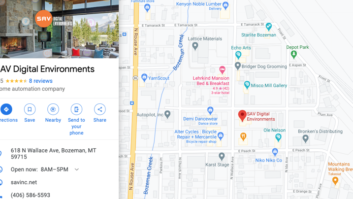Many home technology pros that I speak with think of support as a singular process with the singular goal of solving as many problems as possible, as quickly as possible. The sentiment is understandable. Surely, anyone involved in service and support of any kind wants high solve rates and rapid “time to resolution” (TTR). Thinking of support in such monolithic terms, however, fails to provide a useful framework for measuring and optimizing your process over time.
It’s much more productive to approach it in three distinct phases—basic support, service coordination, and advanced support. Especially if your company is small, you may have a single person or small group performing all three of these phases. However, breaking the process down in this way is still an important exercise. Doing so provides a vastly more granular view of your client-service experience, allowing you to measure and track success (and failures) independently at each point in the process. These insights will help immensely as you work to improve your client experience, bolster your service profitability, and grow your business in a sustainable manner.
Here’s how to break your support process into three distinct phases:
1) Basic Support
“Basic support” is the first phase of any support event. It’s important to note that, during this phase, solve rates, while desirable, are one of the least important metrics to track. The primary goal of this phase is to identify with the client, understanding the “life moment” that is being interrupted, getting a sense of the urgency, and setting clear expectations.
Measure your success here based on the following objectives:
De-escalate the situation. The first goal of basic support is to provide emotional de-escalation. Often, clients in need of support are understandably frustrated. A primary objective of your basic support process is to acknowledge this frustration (but don’t apologize) and assure the client that you will get them taken care of as quickly as possible.
Root-cause analysis. The next goal is to understand the problem through root-cause analysis. Often, clients will call and say something like, “My TV isn’t working.” Quickly and accurately determining whether the issue they are describing is related to a control system failure, a missed HDMI handshake, or a faulty AV component means knowing the right questions to ask.
Provide simple fixes and/or workarounds. Once you’ve de-escalated the situation and gained an understanding of the problem, the next step is to provide simple fixes and/or alternative options. Many issues can be resolved with a simple fix such as rebooting a device, verifying the input, or checking the batteries. If simple fixes do not work, however, your basic support process should include identifying and suggesting appropriate alternative options. The name of the game here is to understand the life moment interrupted by the technology issue and helping the client get back to that moment rather than spend too much time diving into the technology problem.
Manage expectations for follow-up. Assuming your basic support process has not resolved the issue, the final step is to manage follow-up expectations. Laying out a clear plan of action demonstrates to the client that you are in control, which research suggests has a decidedly positive impact on their experience.
Basic support – key takeaways. The key takeaway from breaking down your basic support process in this way is that solve rates are a relatively low priority. Many problems can (and should) be resolved at this phase with simple fixes. Others will have to be escalated.
The fact that these advanced issues must be escalated beyond your basic support process level does not equate to a failure. Performing root-cause analysis, providing emotional de-escalation, managing client expectations, and finding and suggesting alternative options, are all important functions of basic support which you should implement and track independently of solve rates.
2) Service Coordination
Define the next step of your support process as “service coordination.” The name of the game here is to bridge the gap between your basic and advanced support processes. Success during this phase should be measured based on the following objectives:
Establish a game plan. The first step in this phase is to determine the specific plan of action. The specifics will depend entirely on what was determined during the basic support phase. Does it appear a replacement part is needed? Do you have one in stock or does it need to be ordered? Can your programmer be scheduled to perform advanced remote troubleshooting? Or is a site visit in order? The key to success here is to be decisive, arriving at a plan as quickly as possible.
Follow-up. The next step is to follow-up with the client to provide an immediate update. If an on-site visit is needed, coordinate the necessary resources and get an appointment made as soon as possible. Ideally, you have established a service level agreement (SLA) with your clients. If so, success on this step means following-up within the time frame your SLA dictates.
Manage expectations. The final component of the service coordination phase is the ongoing management of client expectations. This includes courtesy steps such as confirming the appointment the day before. This step can also include providing updates if, for example, a replacement part is discovered to be backordered or otherwise delayed in shipping.
Service coordination – key takeaways. Success during this phase of the support event is all about communication. Quickly determining a plan of action, marshaling the necessary resources, and directing traffic with the client all play a critical role in providing a smooth client-service experience. Note that solve rates are not mentioned. In other words, only by breaking down your support process, can you get to the granular point of needing to track success during this critical phase.
3) Advanced Support
The final step of your service process is “advanced support.” Unlike the previous two steps, where solve rates take a backseat as a key performance indicator, advanced support is, at its core, about solving issues as efficiently as possible. Measure success here based on the following objectives:
Advanced remote solves. Don’t assume that because basic support was unable to solve the issue remotely that your remote troubleshooting efforts are exhausted. The first step of this process should be to determine if advanced remote efforts can resolve the problem without a truck roll. This can include performing functions such as remote programming or deep diagnostics or tunneling into the network through a VPN or other method.
Initial site-visit solves. If advanced remote support efforts fail to resolve the issue, then it’s time to roll a truck. During this phase of advanced support, the goal is efficiency. If basic support and service coordination have done their roles successfully, the chances of advanced support fully resolving the issue on the first visit are dramatically improved. In other words, your advanced support technician should have the parts and information he/she needs to maximize the likelihood of success on the first visit.
Track and bill for your time appropriately. If your basic support and service coordination processes are running smoothly, billing for advanced support becomes far easier. By drawing a clear distinction between the three phases, you can easily position a policy to your clients that all advanced support is billable on an hourly basis.
Advanced support – key takeaways. The key goals of this phase are to maximize both advanced remote solves and first site-visit solves. Even though you should be billing for all advanced support, repeat visits create a negative client experience. By focusing on efficiency across both of these metrics, you can ensure the best possible service experience.
Too many integrators fall into the trap of viewing support as a straightforward exercise in solving problems, resulting in a myopic view of what determines service success. Breaking down your process into the three distinct phases of basic support, service coordination, and advanced support provides a vastly more useful framework for optimizing process and measuring success. Doing so will result in a smoother, more predictable client experience, maximize your efficiency and profitability, and ensure that your service operations can scale as your company grows.







